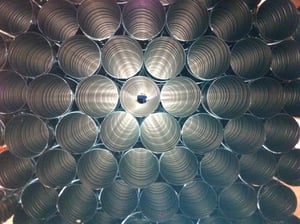Serinus Energy plc (LON:SENX) Chief Executive Officer Jeffrey Auld and Chief Financial Officer Andrew Fairclough caught up with DirectorsTalk for an exclusive interview to discuss first quarter results, challenges faced over the last few months & how they’ve been mitigated and why the share price has dropped this week.
Q1: Andrew, could you just summarise for us your thoughts on Serinus Energy’s first quarter results?
A1: I think for a quarter performance, it’s exceptionally strong.
We generated revenue of just over $13 million and we generated a record earnings for a quarter of $1 million dollars so it’s been a significantly successful financial quarter for us. Cash flow for the period was $3.1 million and we continue to invest in the business. We spent $1.5 million dollars in the quarter, ahead of some significant capital programmes for the following quarters of the year. Cash at the end of the year was $6.2 million as well.
So, we’ve generated cash through the period, we’ve invested through the period and it has been very strong for us. We’ve stabilised production in Romania, quarter on quarter, and we’ve delivered just over 1,115 barrels of oil equivalent per day in the period.
So, it has been a good financial outcome for us. Operationally, we are exactly where we said we would be, and we are positioning ourselves for two significant programmes in each of Tunisia and Romania.
Q2: Jeffrey, what challenges have you faced over the past few months?
A2: That’s a good question, it’s been a pretty dynamic first quarter. I think like many companies, we are starting to see the effects of inflation, we use propane as a refrigerant in our gas plant, just as an example, and propane prices have increased 68% so we’ve had cost increases across the business. We’ve managed to mitigate many of them, but I think the biggest challenge is trying to keep the costs down in the face of some pretty heavy inflation, globally that we really don’t have a means of controlling.
We’ve also seen some very strong commodity prices but there have been disruptions to the supply chain and those have continued. The good news on that is we’re starting to see fabrication delivery times compressed so instead of what we went through last year, where every time we talked to a supplier, the delivery times were getting a little bit longer, we’re in a happy place where every time we talk to a supplier, delivery timelines are getting a little bit shorter.
So, we’ve had challenges, some of them are global and some of them look like they’re challenges that may be passing so it’s been an interesting quarter.
Q3: Now, you did say that you’ve been able to mitigate some of those, how have you been doing that?
A3: Things like inflation, when we’re planning a well campaign, we keep an eye on the spot prices of rolled steel in the market because that’s the best guide we can find to what our tubulars will cost. We started seeing rolled steel futures going up at the end of last year and so we bought tubulars for all of our work overs in Tunisia and we bought tubulars for our work in in Romania.
Andrew commented on the strong financial quarter, one of the benefits of having those strong finances, which weren’t just driven by high commodity prices but certainly were helped, is that we’re able to do things like this to try to mitigate inflation by carrying a little bit more inventory. We went very much to a ‘just in time’ inventory, now we’re expanding inventory again, simply because rolled steel prices and tubular have doubled in price and so we were able to buy before that cost increased came so our well costs haven’t inflated.
So, there’s interesting ways to try to mitigate it. It is global inflation and keeping your eye on futures that give it a lead indicator to what the fabricated products might be doing is one way that we do that.
Q4: Andrew mentioned earlier about the investment in two programmes that are up and coming. Can you just reminder us of what those work programmes are in Tunisia and Romania?
A4: We’re kicking off very shortly in Tunisia with a workover programme on the Sabria W-1 well, that’s a well we’re looking to put artificial lift in so we’re going to put a pump into that. Immediately upon completion of that work over, we’re going to move the rig to the N-2 well, that was a well that was damaged when it was originally drilled many, many years ago. It goes right into our formation, and we’re going to pull the bottom hole completion out and the bottom hole assembly out and we’re going to see if we can get that well to produce again. So, that’s going on in Tunisia, that is imminent, all the equipment, everything’s sitting in the field waiting for a rig. The rig is with a competitor in Tunisia doing a workover programme for them, as soon as they release that from their workover programme, we’ll have that rig for our 90-day program.
In Romania, we’ve just finished a 2D seismic programme that we started planning in November. We planned, designed and executed it, got the results back, in a 5-month program and that was designed to highlight where we wanted to drill on our next three prospects that surround the Moftinu gas field. So, those locations have now identified, we’re permitting those, permitting in Romania is a fairly bureaucratic process so that’s into the hands of the bureaucrats, although we keep pushing them. As soon as we have those permits in place, we’ll kick off a three well drilling programme, prospects that are adjacent to the gas field, they’re within 5 kilometres of the gas field so were we to have a discovery, we could tie those back into the gas field very quickly.
So that’s the work we’re planning, it’s a busy, busy second half of the year. The first half of the year has been putting everything in place to get doing the operational work in the field.
Q5: Now, despite the strong financial results, operations performing very much as you’ve been highlighting quarter on quarter, the artificial lift programme about to start with Sabria W-1 and also permitting for the Romanian exploration company underway, the shares have fallen sharper this week. Could you share your views on that?
A5: We understand it’s about production and we’ve tried very hard to communicate that shallow gas fields, they’re great, they’re a quick pop of gas and then they decline sharply so you get cash flow right up front and that’s what Moftinu did. The trick here is to fill in behind them so you keep your invested capital, the gas plant, you keep that optimised, and that’s what we’re doing.
I think the frustration is that the production is lumpy because we’re a small company, we’ve stabilised the production in Romania quarter on quarter, it’s flat, we’ve stabilized that by putting compressors in but that production will not grow until we get these new wells in place. These new wells, it takes time to run 2D seismic, it takes time to permit locations, it takes time to interpret seismic so there’s a time component that’s built in.
I think one of the things that we really try to highlight is that will be a lumpy cash flow, it will be lumpy production but the strength of our business is a control of costs, such that in those periods where production is declining before we get our next project on stream, we’re generating strong cash flow, we’re building the business, building the investible capital of the business. So, the operating cash flow is accruing to the next phase of investment and that’s what happened here.
I think we’re all very, very disappointed with the share price, however, we do understand that it’s about production, we believe we have a lot of very interesting projects coming up in the second half, it’s always been about the second half, and as painful as it is for us, we sit and we wait for our projects to come to fruition in the second half.









































